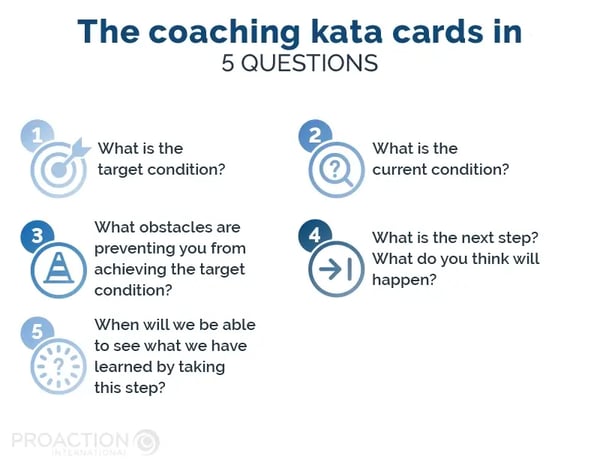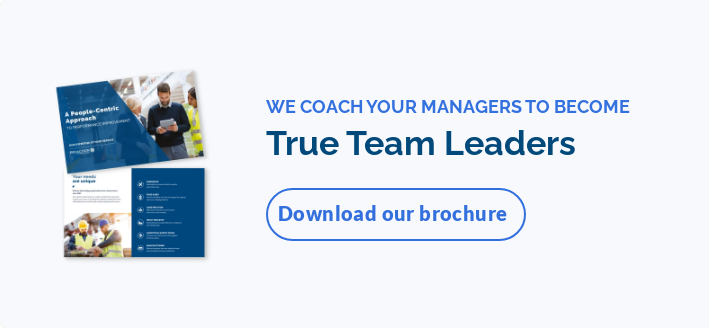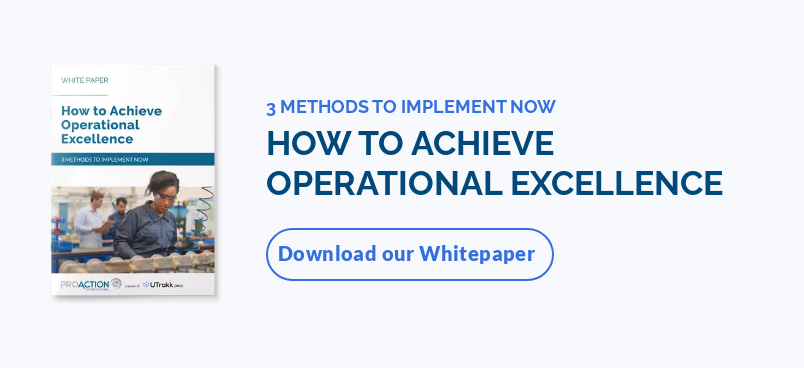What is Toyota Kata?
Toyota Kata is a practice developed by American researcher Mike Rother to structure learning and continuous improvement routines inspired by the Toyota Production System. It involves two key habits – improvement kata and coaching kata.
In his book Toyota Kata: Managing People for Improvement, Adaptiveness, and Superior Results, he explains why some organizations fail to fully leverage Lean's potential while others – like Toyota – achieve higher performances by integrating improvement and adaptation into their employees' daily work. He also demonstrates that Toyota's model can be applied to all processes and industries, from factories to services.
The key principles of Toyota Kata
Long-term vision and strategic alignment
Every action is part of a clearly defined overall objective, to which everyone contributes at their own level. Toyota Kata thus links experimentation cycles to the overall strategy, ensuring that ad hoc progress supports the organization's vision.
Repetition and routines to learn
The strength of Toyota Kata lies in a regular, daily practice, which becomes second nature over time. By repeating these sequences, teams develop their ability to analyze, test, and solve problems, and are able to use them every day without having to think about each step.
Quick and iterative experimentation
Toyota Kata values continuous experimentation – rather than seeking the perfect solution, it favors gradual progress. Each short cycle allows for quick testing, observation, and adjustment, which promotes constant learning process, great agility, and ongoing improvement of work processes.
Exploration of root causes
Toyota Kata encourages understanding before acting. Seeking the root cause of a problem – by using the 5 Whys method, for example – helps to identify blockages better, develop collective skills, and implement effective solutions.
Manager as coach
The manager acts as a coach, guiding their teams instead of supervising them. Through this stance, they ask relevant questions, stimulate the learner's scientific thinking, and provide support without imposing answers. Such a coaching approach develops employee autonomy and accountability.
Improvement kata and coaching kata
Borrowed from Japanese martial arts, “kata” means “form.” It refers to a series of repeated and coordinated movements that become natural over time. Performed consistently, these exercises evolve into perfectly mastered routines and lead to the continuous refinement of technique.
Within organizations, this translates into two katas:
-
Improvement kata: This kata refers to the routine by which employees carry out the steps required to improve work processes.
-
Coaching kata: Through this kata, managers support employees in implementing the improvement kata.
The Toyota Kata involves at least three participants – a learner (who practices), a coach (who guides), and a second coach (who observes and supports the process).
Improvement kata
A scientific method meant to be applied daily, the improvement kata implements a structured system for continuous improvement (Kaizen) within teams. It helps them incorporate new habits, develop scientific thinking, experiment innovative ideas, and perfect their work practices.
Improvement kata is a four-part model:
.webp?width=600&height=651&name=PAI_Blogue_ToyotaKata_4etapes_EN%20(1).webp)
1. Define the target condition
What’s the company’s direction (or challenge)?
Set a clear, time-bound, and measurable goal. This global objective will help stay focused and engage teams around a specific and motivating target.
2. Understand the current condition
What’s the current situation?
Analyze current operations – map work processes, measure them using continuous improvement metrics, and analyze data. Often called the “challenge grasp”, this step ensures teams fully understand the facts and barriers before thinking about the following target condition.
3. Set the next target condition
What’s the next goal to achieve (or challenge to overcome)?
The next target condition is a short-term goal that moves you closer to the final objective. It acts as an intermediate milestone, helping you make steady progress without feeling overwhelmed by the broader objective.
4. Experiment to overcome obstacles
How to achieve the next target condition?
Quickly conduct experiments to address the identified obstacles. Observe the results, make the necessary adjustments, and repeat the process until the target condition is reached. Applying the PDCA cycle (Plan-Do-Check-Act) helps refine corrective actions and ensure steady progress along the way.
Coaching kata
To become a lasting habit, the improvement kata must be supported by the coaching kata. Its mission is to transform team leaders and managers into coaches capable of guiding their employees throughout the improvement journey.
Rather than providing ready-made solutions, the coach guides the learner by asking five questions related to the steps of the improvement kata:

-
What is the target condition?
-
What is the current condition?
-
What are the obstacles preventing us from achieving the target condition?
-
What is the next step?
-
What have we learned from this action?
The fifth question is expanded with four sub-questions to fully learn from the experience:
-
What was the planned final step?
-
What were the expected results?
-
What actually happened?
-
What have we learned from this experience?
The foundation of coaching kata, these questions must be asked in the correct order as each answer builds on the next. In addition to strengthening discipline and clarity, they create a learning mindset – the learner gains confidence, becomes accustomed to experimenting, and realizes that all incremental steps are a step toward achieving the goal.
These coaching kata questions apply to all contexts and hierarchical levels. By integrating them into daily work, organizations ensure process optimization, skill development, and employee autonomy.
The benefits of Toyota Kata for companies
-
Alignment between management and floor teams: By defining clear objectives based on the realities of the shop floor, Toyota Kata ensures everyone understands the direction and can plan the steps needed to achieve it.
-
Sustainable performance gains: By reducing inefficiencies, optimizing processes, and implementing sustainable solutions, companies improve their productivity, qualité, delivery, and much more, leading to outstanding operational performance.
-
Better decision-making: By applying scientific thinking rooted in experimentation and factual analysis, decisions are guided by observation and concrete evidence rather than intuition. This practice enables the implementation of solutions that are both effective and sustainable.
-
Increased ability to adapt to change: By experimenting regularly and progressing step by step, companies enhance their agility, learning to quickly adapt their processes to unforeseen events and market fluctuations.
-
Improved transparency and collaboration: Asking questions encourages open communication, improves relationship between management and floor teams, and fosters constructive exchanges. Teams can discuss challenges without fear, and solve problems collectively.
-
Continuous innovation: By tackling challenges ranging from simple to highly complex, teams enhance their creativity and ability to design innovative ideas. This continuous cycle of problem-solving drives sustained competitive advantage, turning every obstacle into an opportunity for growth.
-
Increased autonomy and initiative: Employees actively participate in process improvement. Toyota Kata gives them the opportunity to experiment, adjust solutions, and see the direct impact of their ideas and actions on the organization’s success.
-
Skills development: Toyota Kata is a practical training tool – repeating routines helps to strengthen employees’ expertise, while enabling them to acquire cross-functional skills such as problem-solving, creativity, and proactivity.
-
Increased motivation: Employees feel valued and engaged when they see the tangible results of their work. Witnessing the impact of their efforts fosters employee motivation and pride.
Best practices to execute a flawless Toyota Kata
1. Master Kaizen
Toyota Kata is grounded in the Kaizen philosophy of continuous, incremental improvement. Successfully implementing Kaizen requires clearly defined objectives, a step-by-step practice aligned with the improvement kata pattern, and adherence to a proven continuous improvement methodology.
2. Train and coach teams
According to Mike Rother, continuous improvement at Toyota depends heavily on field coaching and consistent practice. The more the kata routines are performed, the more intuitive they become. Guided by experienced coaches, teams can apply this approach effectively, ensuring its proper implementation and long-term impact.
3. Provide quality coaching
The coach plays a central role in implementing the approach before, during, and after each session. They define coaching objectives, teach and guide practice while correcting mistakes, and help teams analyze results to learn lessons and identify areas for improvement.
4. Practice regularity
Toyota Kata only delivers results when performed consistently. Practices need to be repeated frequently and in short cycles to become second nature. For example, they can take the form of a brief starter kata carried out daily or weekly, during which teams follow the steps of the improvement kata.
This regular cadence maintains momentum, minimizes setbacks, and fosters continuous learning. Over time, consistency transforms practice into culture.
5. Get management support
Implementing Toyota Kata often involves deep changes that must be addressed carefully. Management plays a crucial role in such change management – leaders must express a clear vision, give meaning to the initiative, and provide the necessary resources to succeed. Sustainable improvement culture cannot take root without strong commitment.
Among clients who have successfully implemented Toyota Kata, senior managers often took the lead as coaches. By engaging directly on the shop floor, they highlighted the value of the approach. This is key to fostering a genuine culture of continuous improvement.
Yves LeBrasseur, Senior Expert, Technical Processes, Proaction International
From routine to performance: The power of Toyota Kata
With its improvement katas and coaching katas, Toyota Kata becomes a powerful tool for establishing experimentation and action routines that help achieve operational objectives while strengthening team skills. Relying on regular practice and coaching, this approach develops autonomy, adaptability, and innovation required to eliminate problems and continuously progress.
Improvement katas and coaching katas enrich Lean Manufacturing when combined with other Lean tools such as Kanban, Value Stream Mapping (VSM), Gemba Walk, 5S, and Kaizen. Together, these methodologies create a mindset of constant improvement that helps organizations gain a competitive advantage by becoming more agile, resilient, and high-performing.









